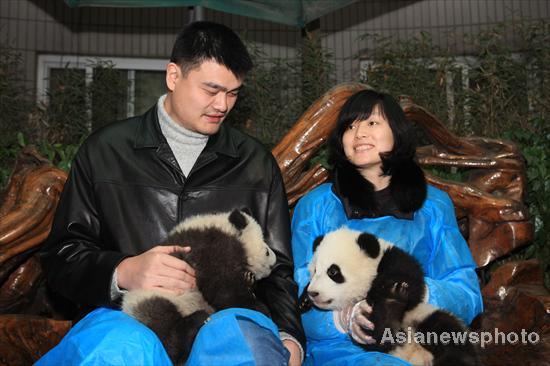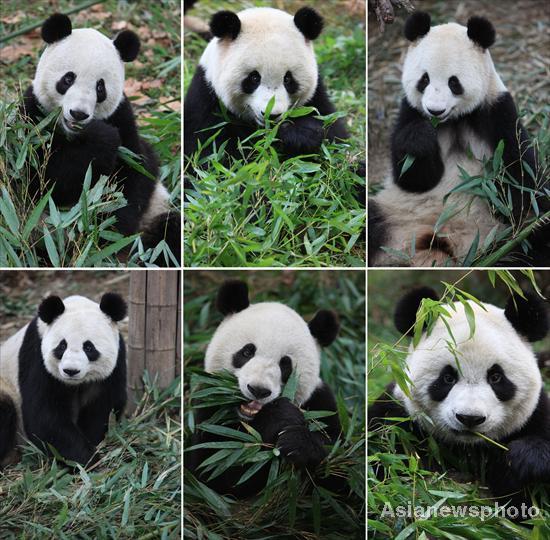Yao Ming helps release 6 pandas
 0 Comment(s)
0 Comment(s) Print
Print E-mail
China.org.cn, January 12, 2012
E-mail
China.org.cn, January 12, 2012
Former NBC star Yao Ming was relaxed while visiting the nursery in the Chengdu Research Base of Giant Panda Breeding in this capital of Sichuan province, on Wednesday afternoon.
|
Yao Ming and his wife Ye Li hold two panda cubs during a panda releasing ceremony at Chengdu Research Base of Giant Panda Breeding, Jan 11, 2012. |
Yao visited the Chengdu base after participating in the opening ceremony for Panda Valley in Dujiangyan, a city under the administration of Chengdu, in the morning.
Six young pandas bred in captivity were released as a group of "pioneers" into the valley, a controlled wilderness designed to train pandas before sending them into the wild. It was formally opened to the pandas on Wednesday in Yutang, a town in Dujiangyan.
"A lot of times when we work on the development of a city or village, we should also consider the natural living environment for the giant panda. It shouldn't be that we just think of giving them food and lodging inside a house," Yao said
Covering nearly 134 hectares, the valley, created with a total investment of 300 million yuan ($48 million), can prepare 30 to 40 pandas for life in the wild.
According to Fei Lisong, deputy director with the center, after a year observing their health and researching their genetic backgrounds, the six -- Xingrong, Xingya, Gongzai, Yingying, Zhizhi and Qiqi-- were carefully selected from 108 pandas living at the Chengdu Research Base of Giant Panda Breeding.
"They are in their subadult age, similar to the childhood of human beings, with comparatively strong survival ability and rapid growth. And Xingrong and Xingya are twins," he said.
|
|
|
Combination photo shows the six pandas bred in captivity to be released into wild at the Chengdu Research Base of Giant Panda Breeding, Dec 21, 2011. [File photo/Asianewsphoto] |
Thirty to 40 pandas will follow the first six before the program is gradually extended to all the pandas in the Chengdu base, which plans to increase the number of pandas to 120 to 150 in 10 years, according to Zhang Zhihe, chief of the research base.
The first six pandas were relocated on Wednesday morning from Zhang's base to the valley, about 50 km from Chengdu. The two males and four females born between 2007 and 2009 are still immature. They grow rapidly, are bold and have strong ability to adapt to the environment.
The Chengdu base has spent nearly a year choosing them from its 108 pandas based on their pedigree, health, genetic background and gender ratio. "We have spent five decades saving pandas from extinction and have lived with them peacefully. We will spend another five decades or more time sending them to the wild, rather than keeping them in captivity," Zhang said.
Thanks to the joint efforts of several generations of researchers, the base has solved the main difficulties in panda breeding, and it has 108 captive pandas, boasting the biggest captive panda population in the world, Zhang said.
"It was difficult for pandas to be ruttish. It was difficult for them to be pregnant, and it was difficult for their cubs to survive. These were the three difficulties in panda breeding," he said.
Coupled with the population growth is the risk of cross-infection of contagious diseases as the pandas are densely populated in his base. In addition, urbanization has an adverse effect on its surrounding environment.
To find an alternative, the base decided to build the valley in 2006 with the support of the central government.








Go to Forum >>0 Comment(s)